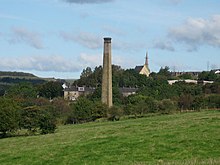Quarlton
| Quarlton | |
|---|---|
 | |
| Area | |
| • 1891 | 798 acres (3.23 km2)[1] |
| Population | |
| • 1801 | 238 |
| • 1891 | 251 |
| History | |
| • Created | Middle Ages |
| • Abolished | 1898 |
| Status | Township (until 1866) Civil parish (1866–1898) |
Quarlton was a township of the civil and ecclesiastical parish of Bolton le Moors in the Hundred of Salford, Lancashire, England. It lay 4+1⁄2 miles (7.2 km) north east of Bolton.[2][3]
Topynomy
Quarlton is derived from the Old English cweorn and dun meaning the mill hill. A cweorn was a millstone.[4] Quarlton was recorded as Quernedon in 1301, Querndone in 1302; Quordone in 1309 and Quarndon or Quarnton were frequently used until modern times.[2]
Manor
The manor originated as two oxgangs of land in Edgworth which the Radcliffes kept on granting the main portion to the Traffords. Ellis de Quarlton contributed to the subsidy in 1332. Quarlton was held by the Radcliffes of Smithills Hall, and the Bartons, and was sold in 1723 by Lord Fauconberg. The Knights Hospitaller held land in Quarlton from early times, the land was occupied by the Smithills family. Mrs Julia Wright of Macclesfield inherited the manor from her father the Rev. Henry Wright.[2]
Quarlton was a sparsely populated hamlet with few houses. In 1666 no houses had more than two hearths liable to the hearth tax, and the total number of hearths was 21. By the mid 19th century the population was employed in collieries and the Quarlton Vale calico print-works which were established early in the century.[5]
Governance
Quarlton ceased to exist when it was incorporated into the village of Edgworth in 1898,[2] within the Urban District of Turton
Geography
Quarlton was a boundary township to the north east of the ancient ecclesiastical parish of Bolton le Moors on the slopes of the West Pennine Moors and had an area of 798 acres (3.23 km2) which was mostly moorland and pasture. The hamlet lay at a height of about 650 feet (200 m) above sea level, the ground rises rapidly to the north-east to over 1,250 feet (380 m) at the boundary.[2][6]
Demography
| Year | 1801 | 1811 | 1821 | 1831 | 1841 | 1851 | 1861 | 1871 | 1881 | 1891 |
|---|---|---|---|---|---|---|---|---|---|---|
| Population | 238 | 295 | 320 | 376 | 370 | 361 | 253 | 264 | 271 | 251 |
| Sources: Local population statistics.[7] Vision of Britain.[8][9] | ||||||||||
References
Notes
- ^ "Quarlton Area (acres)". Vision of Britain. Retrieved 13 August 2010.
- ^ a b c d e Farrer, William; Brownbill, J., eds. (1911), "Quarlton", A History of the County of Lancaster: Volume 5, British History Online, pp. 284–285, retrieved 13 August 2010
- ^ Quarlton Township Map, genuki.org, retrieved 13 August 2010
- ^ Mills 1976, p. 123
- ^ Samuel Lewis, ed. (1848), "Quarlton", A Topographical Dictionary of England, British History Online, pp. 623–627, retrieved 13 August 2010
- ^ Bolton Area Map: Ancient Parishes and Townships, Boydhouse, retrieved 9 August 2010
- ^ Tatton, Pauline. Local population statistics 1801–1986. Bolton: Bolton Central Library Archives.
- ^ "Gazetteer entries for Quarlton". Vision of Britain. Retrieved 13 August 2010.
- ^ "Quarlton CP/Tn: Total Population". Vision of Britain. Retrieved 13 August 2010.
Bibliography
- Mills, David (1976), The Placenames of Lancashire, Batsford, ISBN 0-7134-5236-6
